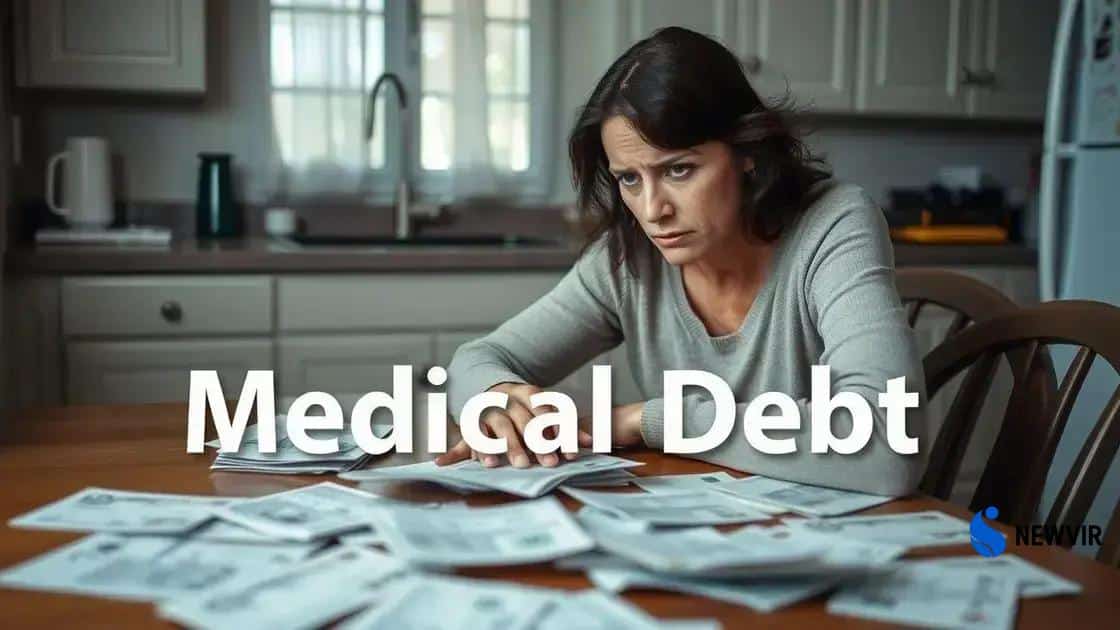Changing frameworks for managing medical debt policies

Changing frameworks for managing medical debt policies focuses on increasing transparency, expanding financial assistance, and integrating technology to help patients navigate their medical expenses more effectively.
Changing frameworks for managing medical debt policies is a topic gaining traction as healthcare costs soar. Have you ever felt overwhelmed by medical bills? This article unpacks how evolving strategies can ease this burden.
Understanding medical debt policies
Understanding medical debt policies is essential for patients navigating the often confusing world of healthcare. Many people find themselves overwhelmed by unexpected medical bills that can lead to financial stress. This section aims to break down these policies in a clear and digestible manner.<\/p>
What Are Medical Debt Policies?<\/h3>
Medical debt policies refer to the regulations and guidelines that govern how medical debt is managed by healthcare providers and financial institutions. These policies dictate how medical bills are created, how payments are collected, and the rights of patients when facing medical debt. Understanding these policies can empower patients to take charge of their finances and seek assistance when needed.
Key Aspects of Medical Debt Policies<\/h3>
- Transparency in billing practices
- Protection against aggressive collection tactics
- Options for payment plans
- Access to financial assistance programs
These aspects are crucial for ensuring that patients have a fair chance at managing their medical expenses. Many hospitals and providers have set up their own financial assistance programs to help those who are struggling.
In addition to hospital policies, state and federal laws can also play a significant role in protecting patients from burdensome medical debt. For instance, some states have laws that limit how long a provider can pursue collection efforts after a bill has been issued.
The Impact of Medical Debt on Patients<\/h3>
Understanding how these policies affect patients is vital. High levels of medical debt are linked to increased stress, anxiety, and even deferment of necessary medical care. Patients often choose to ignore past due bills, which can lead to collections and further financial trouble.
By knowing their rights and the available support options, patients can navigate the challenging landscape of medical debt more effectively. This knowledge can inspire confidence and reduce the stigma associated with seeking help.
The impact of medical debt on patients

The impact of medical debt on patients can be profound and far-reaching. Many individuals face serious challenges when trying to manage their medical expenses, often leading to increased stress and anxiety. When patients receive unexpected medical bills, it can create a sense of uncertainty and fear about their financial future.
Emotional Effects of Medical Debt<\/h3>
Patients dealing with medical debt may find themselves overwhelmed. This financial burden can lead to feelings of shame and frustration. Many studies indicate that medical debt contributes to stress-related health issues, including depression and anxiety.
Financial Consequences That Follow<\/h3>
The financial strain from medical debt doesn’t just affect the present; it can also have long-term consequences. Patients might be forced to choose between paying medical bills and covering essential living expenses. In some cases, this results in:
- Delayed medical treatment for necessary procedures.
- Decreased credit scores, making it harder to secure loans.
- Increased risk of bankruptcy.
- Impact on mental health due to constant worry about finances.
Additionally, many patients report being unable to access follow-up care due to fear of accumulating more debt. This cycle can lead to adverse health outcomes, as necessary health services are delayed or avoided altogether.
Ultimately, the intertwining issues of medical debt and health outcomes create a stressful reality for millions. Addressing this problem requires awareness and proactive steps to improve policies and offer better support for those impacted by health-related expenses.
Frameworks for effective medical debt management
Frameworks for effective medical debt management are essential for helping patients navigate their financial responsibilities without compromising their health. These frameworks consist of various strategies and practices that healthcare providers, insurers, and patients can utilize to make the system more manageable.
Key Strategies for Managing Medical Debt<\/h3>
Understanding and implementing effective strategies is crucial. Hospitals and healthcare providers often have programs in place to assist patients. Some of these strategies include:
- Establishing payment plans that allow patients to pay bills over time.
- Offering financial counseling services to help patients understand their options.
- Creating clear communication about billing processes and patient rights.
- Implementing sliding scale fees that adjust based on income.
These strategies play a role in reducing the burden of medical debt on patients. By providing more transparency and support, healthcare systems help patients feel more secure about their financial obligations.
The Role of Nonprofits and Community Resources<\/h3>
Nonprofits and local organizations also contribute significantly to medical debt management. They offer resources that educate patients about their rights and available assistance programs. Patients can benefit from:
- Workshops on financial literacy related to health care.
- Accessing funds for those who qualify for assistance with bills.
- Support networks that connect individuals with others facing similar challenges.
These community-focused efforts can alleviate the stress associated with medical debt, leading to improved health outcomes as patients are more likely to seek necessary care without fear of financial repercussions.
Building an effective framework means actively engaging patients in their health care decisions. Educating them about their rights and options empowers patients to take control of their medical debt, fostering a healthier relationship with their healthcare providers.
Innovative solutions for reducing medical debt

Innovative solutions for reducing medical debt are essential in today’s healthcare landscape. Many patients struggle with high bills, leading to a pressing need for new approaches that can ease this financial burden and improve access to necessary medical care.
Technological Advancements in Healthcare<\/h3>
One of the notable innovations is the use of technology to streamline billing processes. Digital tools allow healthcare providers to create clear and accurate bills, helping patients understand their charges better. This clarity can significantly reduce disputes and delays in payments.
Some healthcare systems have begun using mobile apps to help patients manage their medical expenses. These apps often provide:
- Real-time updates on insurance claims and billing.
- Tools for creating personal budget plans related to healthcare costs.
- Access to financial assistance programs tailored to individual needs.
By leveraging technology, patients can gain control over their finances and make informed decisions about their healthcare.
Community-Based Approaches<\/h3>
Another innovative solution stems from community resources. Many communities have started initiatives to help those with medical debt. For example, local nonprofits may offer free workshops on financial literacy and healthcare financing. These workshops equip participants with the knowledge to navigate their medical expenses more effectively.
Additionally, community health organizations can connect patients with resources such as:
- Emergency funds to cover unexpected medical costs.
- Partnerships with hospitals willing to reduce bills for low-income families.
- Programs promoting preventive care to minimize future medical expenses.
With these support systems in place, individuals can avoid accumulating excessive debt and receive the care they need when they need it.
Furthermore, innovative policy changes are being proposed at various levels of government to address medical debt at its roots. These changes aim to provide better protections for patients and ensure fair practices in medical billing.
Future trends in medical debt policies
Future trends in medical debt policies are shaping how healthcare expenses will be managed in the coming years. As medical costs continue to rise, new strategies are emerging to provide relief for patients struggling with debt.
Increased Transparency in Billing<\/h3>
One significant trend is the push for greater transparency in medical billing. Patients often face confusion regarding their bills, which can lead to disputes and delayed payments. Future policies may require healthcare providers to clearly outline costs and procedures upfront. This could include:
- Standardized billing formats that are easier to read.
- Detailed breakdowns of procedures and their associated costs.
- Clear information about insurance coverage and out-of-pocket expenses.
Such transparency will empower patients to make informed decisions and could potentially lead to lower levels of medical debt overall.
Expansion of Financial Assistance Programs<\/h3>
Another emerging trend involves the expansion of financial assistance programs. Many healthcare facilities are recognizing the need to support low-income patients better. Initiatives may include:
- Broader eligibility criteria for financial aid.
- Collaboration with local nonprofits to provide additional resources.
- Outreach efforts to educate patients about available support.
With enhanced financial aid, patients may be less likely to face overwhelming bills, which will contribute to reduced medical debt.
Furthermore, technology will play a vital role in these future trends. Digital tools can facilitate communication between healthcare providers and patients, leading to more efficient billing processes and quicker resolution of issues.
Moreover, the incorporation of health insurance reforms may be on the horizon, aiming to protect patients from excessive out-of-pocket costs. This is an essential step towards achieving fairness in medical care and ensuring that patients receive necessary treatment without the fear of financial ruin.
FAQ – Frequently Asked Questions about Medical Debt Policies
What are medical debt policies?
Medical debt policies are guidelines that govern how healthcare expenses are managed, including billing practices and patient rights.
How can I manage my medical debt?
You can manage medical debt by setting up payment plans, utilizing financial assistance programs, and staying informed about your billing details.
What role does technology play in reducing medical debt?
Technology helps streamline billing processes, provides real-time updates, and enables patients to access information about financial assistance easily.
How can community resources help with medical debt?
Community resources can provide education, financial aid, and support networks to assist individuals in managing and alleviating medical debt.






